| | Factors influencing weed competition | Crop and weed density | Weed problems in wheat and yield losses due to specific weeds | Weed control | Herbicide resistance
Adapted from the Canada Grains Council's Complete Guide to Wheat Management
Factors influencing crop production can be divided into three groups. Firstly, yield-defining factors such as radiation; secondly, yield-limiting factors which include soil moisture, nutrient availability and length of growing season; and thirdly, yield-reducing factors which encompass disease, insects and weeds. The presence of weeds within a crop can adversely affect production in a number of ways. Losses may be incurred through increased harvest costs. The presence of immature weeds (green material) at harvest will result in the crop having to be swathed rather than straight-combined, and potentially the rate of swathing could be reduced. Increased dockage, storage and transportation costs result from weed seeds in the grain, and weed seeds in the soil can result in increased future tillage and weed control costs. The greatest single cause of economic loss is, however, a reduction in yield due to weed competition with the crop for available light, nutrients and moisture.
Wheat yield losses due to weed competition can primarily be attributed to a decrease in tillering. Irrespective of soil fertility or crop seeding rate, wheat tillering gradually declined with an increase in wild oat density. When wild oats exceeded 200 plants/mē, tillering is reduced by greater than 50%. Reduced tillering of wheat has also been observed in the presence of green foxtail, blackgrass, ryegrass, Russian thistle, wild buckwheat and volunteer canola. Although tillering is reduced, the 1000 kernel weight is generally unaffected.
Recent changes in crop rotations has led to increasingly common, wheat – canola rotations which, in turn, has led to an increasing problem with volunteer canola. Open pollinated varieties of B. napus from the 1970s have been found to reduce wheat yields at rates of 0.24 to 2.4% per B. napus plants/meter at low weed densities (O’Donovan 2008). Hybrid canola is even more competitive. Using hybrid canola variety volunteers reduced wheat yields by 0.41% per plant when using progeny of hybrid canola. However, succeeding generations from the progeny of hybrid canola sometimes did have reduced competitive ability. The competition effect was very much dependent on the original variety(Seerey and Shirtliffe, 2010). The table below demonstrates the variation in competition from various varieties.
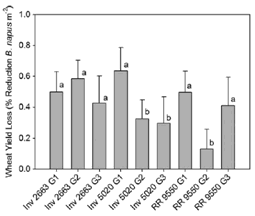
Fig. 2. Effect of variety and generation on proportion of wheat
yield loss in response to competition with low densities of
B. napus, as modeled by mature plant density. Error bars
represent standard error associated with each yield loss
estimate. Comparisons are made within plant varieties, and
not between plant varieties and generations. Treatments with
similar letter indicate no significant difference (PB0.05)
between scores.
In addition to the different competitive ability of volunteer canola there is also a difference in competition from various wheat varieties. There is little information available on the effects of weed competition on the quality of wheat grain. It has been shown that wild oat competition does not adversely affect nutrient content of wheat grain.
Factors Influencing Weed Competition
Weed-crop competition is a complex field of study. The extent of competition is governed by a number of factors including crop species, crop cultivar, crop density, weed species, weed density, the relative time of emergence of the crop and weed, the duration of the weed presence, the efficiency of weed control, and soil and environmental factors.
Crop species and cultivar
Of the four major crops, wheat, barley, canola and flax, wheat ranks third in its competitive ability. Barley and canola (once well established) are more competitive, and flax the least . Winter wheat is generally considered to be more competitive than spring wheat, largely due to the fact it has a head start over the weed species. Perennial weeds, such as Canada thistle, are probably of greater significance than annual grassy and broadleaved weeds in winter wheat production.
Competition evidence indicates that semi-dwarf wheats are less competitive than normal-height wheats.
Similarly, the long-strawed spring wheat, was observed to be a better competitor with wild oats than the short-strawed cultivar. In both these studies, the greater shading of the semi- dwarf wheat by the weeds was implicated as a factor responsible for the differential effects of weed competition on the yields of the two cultivars. Although there are some exceptions, short-strawed winter wheat cultivars also tend to be poorer competitors with annual weeds than tall cultivars.
Within tall- and short-strawed cultivars, weed competition has been observed to result in differential yield responses. Generally, the higher- yielding cultivars appear to be more severely affected by weed competition than the lower- yielding ones.
Crop and Weed Density
The actual weed density at which wheat yield losses occur is weed species and environmentally dependent. Generally, the greater the weed density, the greater the yield losses (Figure 1).
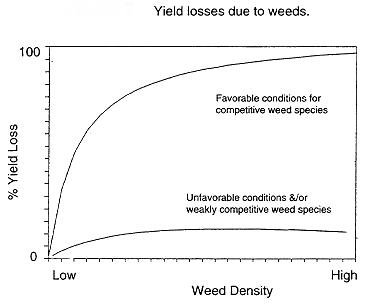
Several studies have shown this to be the case for wild oat competition in wheat. Irrespective of soil fertility, on previously summerfallowed land, 48 wild oats/mē significantly reduced wheat yield, and with increasing density above 48 wild oats/ mē, yield losses increased (Table 1).
Table 1. The effect of wild oats on the yield of wheat grown on summerfallow land (average of three years data).
Wild oat
density
(plants/mē) | % Wheat yield loss |
| Fertilized | Unfertilized |
| 0 | (30.3)* | (29.8)* |
| 12 | 6 | 11 |
| 48 | 16 | 23 |
| 84 | 28 | 30 |
| 120 | 27 | 37 |
| 156 | 32 | 42 |
| 192 | 43 | 44 |
| 228 | 44 | 53 |
* Wheat yield (bu/ac) from weed-free check. Source, Bowden and Friesen, 1967.
These results correlate well with other studies. On fertilized stubble land, wild oats at a density of only 12 plants/mē were found to significantly reduce wheat yields, while on unfertilized stubble land, 80 to 120 wild oats/mē were required before yield losses were significant.
Increasing tartary buckwheat density has been shown by a number of researchers to result in increasing wheat yield losses. The density of tartary buckwheat at which a significant yield loss was observed varied considerably from 14 plants/mē to 58 plants/mē. This differential probably reflects differences in cultural practices and environmental conditions.
Increasing crop density has been implicated in a number of instances as reducing the competition of weeds. By increasing crop seeding rates, weed growth and therefore competition may be suppressed. Wheat yield losses from wild mustard competition decreased with increased crop seeding rates of 67,135 or 200 kg/ha. The yield of wheat in the weed-free plots was, however, less at the higher seeding rates probably due to competition from the wheat itself.
Increasing wheat seeding rates from 22 to 44 or 88 kg/ha decreased the yield-reducing effect of wild oats from 78% to 64% and 77% to 44%, respectively. Researchers caution, however, that although increasing wheat density reduced the yield loss due to wild oats, this effect was negligible once the optimum weed-free density was exceeded. Wheat yields declined much more strongly in response to wild oat pressure at low, compared to high, crop densities (Figure 2). In Western Canada, usually moisture is the limiting factor. Under dry conditions yield and heavy seeding, can actually lower crop yields through competition for moisture.
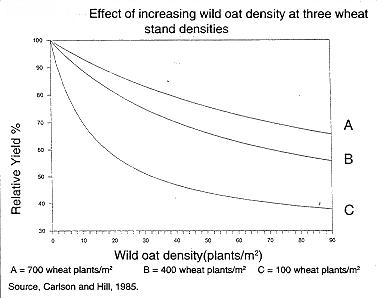
Relative time of emergence
The relative time of emergence of the weed and the crop influences the degree of competition. Generally, the species which germinates or emerges first gains the upper hand. The earlier the weed emerges prior to the crop, the more time it has to establish and compete.
Russian thistle densities of 4 to 52 plants/mē reduced wheat yields by 20% to 48% in 1983 and 1985, the yield loss increased with increasing Russian thistle density. In 1984, however, although Russian thistle density was greater (20 to 112 plants/mē), yield losses were not significant. The differential effects with year were attributed to the relative time of emergence. Russian thistle emerged two weeks prior to wheat in 1983 and 1985, but in 1984 the weed emerged one week after the crop.
Data within the ECW Research Reports indicate that greater wheat yield losses are generally observed when wild oats or tartary buckwheat emerge prior to the crop.
In the case of wild oats and wheat, reported that for each day of emergence of wild oats before or after emergence of the wheat crop, yield changed by about 3% (Figure 3).
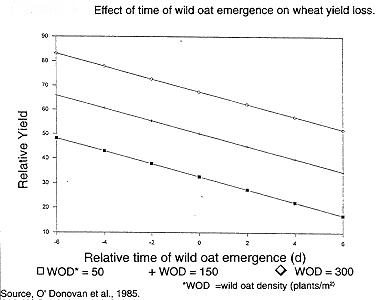
Duration of competition
The duration of competition will influence wheat yield losses and will probably be determinant upon the nature of the weed. Generally, the earlier the weed is removed from the crop, the greater the chances the crop yield will be unaffected.
There are numerous reports of weed removal, through the use of herbicides, enhancing the yield of wheat. If wild mustard was removed from a wheat crop in the early stage (5 to 12.5 cm), then yields were comparable to the weed-free checks. However, if 2,4-D was not applied until the 22.5 to 25 cm stage, then yields were less than in the weed-free checks. Benefits are reduced from the control of wild oats and mustard when application is delayed.
Wild oat competition with wheat commenced at an early stage in the wild oat life cycle. The longer the wild oats remained in the plots, the greater was the yield reduction. Wild oat competition may commence prior to emergence. However, further research has found that significant yield losses does not occur unless the wild oat competition exceeded 20 days or the wild oats exceeded the 5- 6 leaf stage. Herbicide trials indicate the duration of wild oat competition that results in significant wheat yield losses can be somewhat variable.
Soil and environmental conditions
Soil fertility - A number of studies have been conducted to determine the influence of soil nutrients on weed competition. Most of these studies involve nitrogen and phosphorus fertilizer. The results of several studies indicate nitrogen fertilization increased wheat yields. However, weed growth was also stimulated, with the result that the competitive balance between the weed and crop species was unaffected. In some cases where nitrogen in surface spread, then incorporated, weed growth response was greater than crop response. To minimize the benefit to the weeds, it is strongly recommended that fertilizer be soil banded close to the seed row.
Soil moisture - Available soil moisture is probably the most important resource for competing plants. Wild oats possess an extensive root system and can compete effectively for moisture with other plants. Suggestions have been made that wild oats may be more tolerant to reduced soil moisture than some crop plants.
The available soil moisture may also determine the emergence of the crop versus the weed species, e.g. Kochia is able to germinate at low soil moisture (-l3 bars) while green foxtail requires higher soil moisture than wheat for germination and emergence.
Weed Problems in Wheat and Yield Losses Due to Specific Weeds
Weed competition studies are complex in nature and consequently few threshold models have been developed for wheat yield losses due to weeds. The weed competition studies, to date, have primarily involved a single crop/weed species complex, despite the fact that usually more than one weed species is present within the crop. Multi-weed species competition studies are scant. Where more than one weed species is present, the predicted yield losses obtained using the threshold model for a single weed may be greater than that actually observed. In a multi-weed species/crop complex the weeds not only compete with the crop, but compete with each other for resources.
The following section will give weed threshold models where available and, otherwise, the results of yield losses due to weed competition will be given to illustrate the potential problems to wheat producers.
Annual grassy weeds
Of the six annual grasses found in wheat fields of western Canada, only two, green foxtail and wild oats, could be said to be of economic importance. Wild oat/crop competition studies have received the greatest attention from weed scientists, probably because wild oats is one of the most prevalent weeds, and one of the most costly to control. Changes in cropping systems results in a shift in problem weeds. In Southern Alberta, zero tillage has seen a shift in problem weeds with downy brome becoming more prevalent.
Wild oats
A number of studies have indicated that, in general, as wild oat density increases, competition from the weed, and consequently crop losses, increase. Within the literature, a number of threshold models can be found for wheat loss due to wild oat competition. Wild oats tends to proliferate in years with cooler temperatures and high moisture levels.
The earliest predictive model was devised by Dew (1972). The model consists of a simple regression equation:
y = a - b multiplied by the square root of x
where
y = yield
a = predicted weed-free yield
x = wild oat density/mē
b = regression coefficient
The equation was simplified to:
yield loss = ab1 multiplied by the square root of x or % yield loss = 100b1 multiplied by the square root of x
where
b1 = b/a or the 'index of competition'.
Dew (1972) calculated the competitive index for wild oats in wheat to be 0.0339. Thus, at 10 wild oats/mē:
% Yield loss = l00 x 0.0339 x multiplied by the square root of 10 = 10.8%.
There are other models out there that predict yield loss. This research project “Developing an Empirical Yield-Prediction Model Based on Wheat and Wild Oat (Avena fatua) Density, Nitrogen and Herbicide Rate, and Growing-Season Precipitation” by Wagner, N.C.; Rew, L.J.; Taper, M.L.; Maxwell, B.D. found in Weed Science, 2007 Nov attempts to evaluate 5 of these models for a best prediction.
A profusion of predictive models highlights the difficulties in finding one model that accounts for all variable in weed effect on yield.
Table 2. Yield losses of wheat at different densities of wild oats.
 | % wheat yield loss |
Wild oat
density
(plants/mē) | Wild oats
1-leaf stage
ahead | Crop/weeds
emerge same
time | Wild oats at first leaf stage
behind |
| 1 | 20-27 | 11-15 | <5 |
| 5 | 24-32 | 14-19 | 5-7 |
| 10 | 26-35 | 17-23 | 8-10 |
| 14 | 29-38 | 19-26 | 10-13 |
| 22+ | Yield losses and lodging hazard |
Source, Manitoba Agriculture, 1988.
Green foxtail
To date, no threshold models have been developed for green foxtail, probably due to the highly variable competition exhibited by this weed species. Substantial wheat yield losses can be found due to green foxtail competition. Significant yield reduction occur only when green foxtail density exceeded 314 plants/mē. A different study found significant wheat yield losses when green foxtail densities reached 243 and 150 plants/mē. The absence of a wheat yield reduction in 1985, despite green foxtail densities in excess of 2000 plants/mē, may be attributed to the weed species emerging eight days after the crop.
Table 3. Wheat yield losses due to various green foxtail densities.
Green foxtail density
(plants/mē) | % Wheat yield loss |
97 | 8-44 |
194 | 12-46 |
387 | 14-62 |
Source, Goodwin, 1987.
Green foxtail is highly competitive if it emerged either prior to or within one week of the crop, providing the weather conditions after emergence were warm. As a C4 plant, it thrives in hot weather.
If the spring temperatures are warm and the soil is moist, green foxtail emergence is favoured. Early planting of wheat can give the crop an advantage if the soil moisture is low in the top 0 to 4 cm of soil and the temperature is cool. Secondly, if green foxtail emergence occurs prior to or within one week of wheat, yield reductions can be expected and control is advisable.
Annual broadleaved weeds
If the broadleaved weeds emerge prior to or simultaneous with the crop, substantial crop losses may occur. Second flushes of broadleaved weeds, or moderate infestations which emerge after the crop, probably will not compete effectively under an advanced cereal canopy and will not reduce yields substantially. Although a number of annual broadleaved weeds rank in the top twenty weeds of importance, due to their highly unpredictable and variable nature, density threshold models are currently not available. However, the results of competition studies can give an indication of yield losses that may occur in the presence of some of these weeds.
Wild & Tartary buckwheat
Researchers at Lacombe and Vegreville have developed a threshold model for the effect of tartary buckwheat on wheat yields:
Percentage wheat loss = 5.04 + 3.05 multiplied by the square root of x
where
x = the density of the tartary buckwheat (plants/mē).
Thus, at a density of 30 tartary buckwheat/mē, the wheat yield loss would be 5.04 + 3.05 multiplied by the square root of 30 = 22%. It has been suggested that in canola, yield losses due to wild buckwheat are similar to those resulting from tartary buckwheat. A similar situation may arise in wheat, although results indicate wheat yield losses due to wild buckwheat are much lower than would be predicted by the above equation.
Table 4. Effect of wild buckwheat population on yield of wheat.
Wild buckwheat
(plants/mē) | Wheat yield
g/mē (%loss) | Predicted from
above equation* |
0 | 441 |  |
56 | 426 (+3.0%) | 28% |
170 | 398 (3.0%) | 45% |
357 | 371 (10%) | 63% |
395 | 300 (27%) | 66% |
* % yield loss = 5.04 + 3.05 multiplied by the square root of x
Source, Dew, 1978a..
Table 5. Effect of wild buckwheat on wheat yields.
Wild buckwheat density
(plants/mē) | Yield loss
(%) | Predicted yield loss
from above equation (%)* |
54 | 10 - 12 | 37 |
108 | 6 - 20 | 37 |
* % yield loss = 5.04 + 3.05 multiplied by the square root of x
Source, Goodwin, 1987.
Wild mustard
Wheat yield reductions due to wild mustard can be substantial. At two seeding rates of 67 and 135 kg/ha wheat, wild mustard reduced yields. At the lower seeding rate, as low as 60 wild mustard plants/mē reduced wheat yields by 21 % (Figure 4). It is equally competitive as wild oats in spring wheat (Gillespie and Nalewaja 1988).
A more recent study indicates 54 and 108 wild mustard plants/mē can reduce wheat yields by 12% to 20% and 20% to 56%, respectively. Evidence indicates that early removal of wild mustard will result in wheat yields being similar to the weed free-checks.
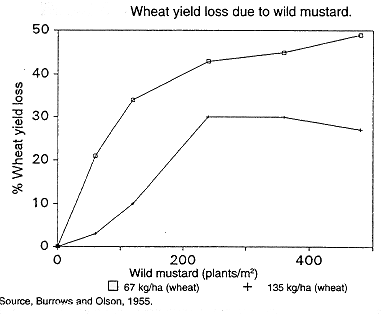
Smartweed
Smartweed will significantly reduce wheat yields at densities of 146 to 1323 plants/mē (Figure 5).
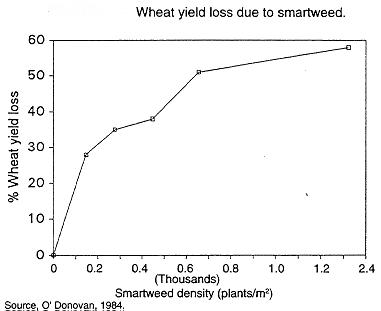
The relative time of smartweed emergence appears to markedly influence the competitive nature of the weed and its effect upon wheat yields. Under an advanced wheat canopy, the competitive nature of smartweed is substantially reduced. Densities of 499 smartweed plants/mē does not significantly reduce yield when the weed emerged 11 days after the crop.
Stinkweed
Densities of stinkweed as high as 686 plants/mē does not significantly reduce wheat yields. This result would tend to suggest that stinkweed is not a good competitor in wheat and yield losses due to this weed would be low.
Table 6. Effect of various densities of stinkweed on yields of wheat.
1977 | 1978 |
Stinkweed
density
(plants/mē) | Wheat yield
(g/mē) | Stinkweed
density
(plants/mē) | Wheat yield
(g/mē) |
0 | 503 | 0 | 399 |
42 | 520 | 37 | 384 |
117 | 506 | 141 | 408 |
374 | 480 | 325 | 360 |
686 | 472 | 758 | 309 |
Source, O'Donovan, 1984.
Hemp - nettle
Hemp-nettle densities of 160 and 215 plants/mē resulted in wheat yield losses of 20% to 22% and 39%, respectively.
Table 7. Influence of various densities of hemp-nettle on yield of wheat.
1979 | 1983 |
Hemp-nettle
density
(plants/mē) | Wheat yield
(g/mē) | Hemp-nettle
density
(plants/mē) | Wheat yield
(g/mē) |
0 | 407 A | 0 | 470 A |
70 | 311 BC | 11 | 463 A |
146 | 327 B | 15 | 439 AB |
213 | 249 D | 31 | 471 A |
398 | 261 CD | 42 | 401 ABC |
 |  | 81 | 401 ABC |
 |  | 139 | 353 C |
 |  | 175 | 369 BC |
In each column, wheat yields followed by the same letter are not significantly different at the 5% level.
Source, Dew, 1979c; de St. Remy and O' Sullivan, 1983d.
Russian thistle
The effects of Russian thistle on wheat yields is dependent upon the relative time of emergence of the weed and the crop. In 1983 and 1985, Russian thistle emerged one week prior to the wheat and densities of 4 to 52 plants/mē reduced spring wheat yields by 20% to 48%. The yield loss increased with an increase in Russian thistle density. In 1984, however, although the Russian thistle density was greater (20 to 112 plants/mē), the weed emerged one week after the wheat and the crop losses were not significant. The weather conditions in 1983 and 1985 were also more favourable towards growth of the Russian thistle as the spring was wet.
Other annual broadleaved weeds
Within the literature, no studies could be found regarding the effects of lambsquarters, redroot pigweed, nightflowering catchfly, chickweed, shepherd's purse and dog mustard competition on wheat yields. In the case of lambsquarters, a recent study found 200 lambsquarters/mē to reduce barley yields by 20% and 23% in 1982 and 1983, respectively (Figure 6). As wheat is a poorer competitor than barley, greater yield reductions due to lambsquarters may be expected in this crop.
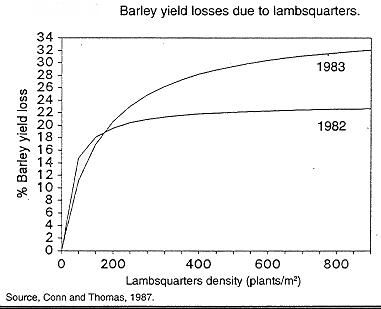
Perennial weeds
Canada thistle, quackgrass and sow thistle are the major perennial weed problems in the prairies. The current trend for reduced tillage systems may alleviate soil degradation but, when cultivation intensity is reduced, there is a shift in problem weeds and Canada thistle populations will increase. Despite the high incidence of the three perennial weeds mentioned, studies on wheat yield losses due to these weed are few. Yield losses due to perennial weeds can be large but a more significant problem arises in letting the weeds spread in the field. Therefore control is necessary right from first discovery.
Quackgrass
A density of 150 quackgrass shoots/mē at harvest reduces wheat yields by 20% (Figure 7). Quackgrass shoot counts prior to harvest can be used to predict quackgrass density at harvest and, therefore, allow prediction of the effects of quackgrass on wheat yield early in the season. For example, if there are 10 shoots/mē recorded 10 days after planting, 150 shoots/mē may be expected at harvest (Figure 8). Referring back to Figure 7, an estimated 20% reduction in wheat yield may be expected when compared to a weed- free situation.
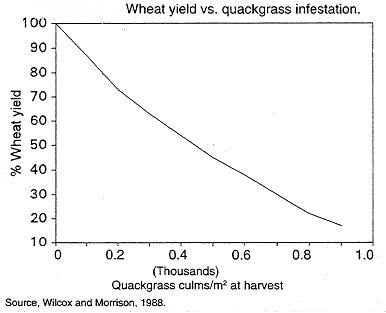
Figure 7.
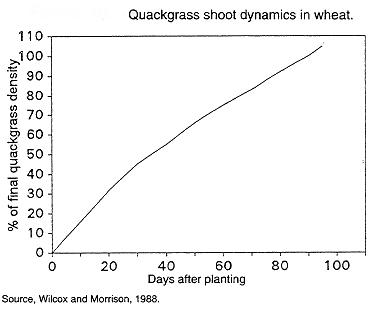
Figure 8.
Canada thistle
Density threshold models for yield losses in barley and rapeseed indicate Canada thistle can markedly reduce yields. As wheat is a poorer competitor than either of these two crops, it seems likely that greater losses may be expected in wheat. The results available on wheat yield losses due to Canada thistle are somewhat variable, possibly reflecting differential environmental or cultural conditions. Ten Canada thistle shoots/mē reduced wheat yield by 6% to 7%, while at 40 shoots/mē a yield loss of 20% could be expected. Earlier reports of Hodgson (1968) indicated that two thistle shoots/ mē could reduce wheat yields by 15%. In view of the predictive models of O'Sullivan et al. (1982) and O'Sullivan et al. (1985) with barley and rapeseed, the observations of Hodgson (1968) seem more applicable. Winter wheat yield losses of 22%, 36% and 45% have been found with 10, 20 and 30 Canada thistle shoots/mē, respectively. In winterwheat production the perennial weeds are not disrupted prior to planting and thus winter wheat may be a poorer competitor than spring wheat.
Weed Control
Successful weed control requires the use of integrated cultural and chemical practices. No one technique will adequately eliminate weed problems.
Prevention
A number of management practices can aid in preventing new weed infestations and reducing the spread of existing weed problems:
- The use of weed-free seed is of extreme importance in reducing weed problems. One wild oat plant can produce 500 seeds; thus, one wild oat seed in a kilogram of wheat could produce five wild oat plants/mē. A few extra dollars expended on weed-free seed would more than compensate for the reduction in weed control costs.
- Ensure that farm machinery is clean so that weeds are not transferred from one field or farm to another.
- Ensure that screenings and grain are covered during transportation.
- Restrict animal movement from weedy fields to clean fields.
- Be careful when importing hay.
- Do not allow weed seeds to set seed. Disrupt or destroy weeds by machine, hand mowing, hand pulling, early harvest, tillage, and grazing.
- Control the spread of weeds through manure by proper composting of the manure.
Physical and cultural control methods
Delayed seeding studies show that wild oat populations may be substantially reduced by such practices. In wheat, reductions of greater than 80% in wild oat density were observed due to delayed seeding. Wheat yields, however, were also substantially reduced and, the economic losses in terms of wheat yield by far surpassed the cost of application of a herbicide for the control of wild oats. Delayed seeding should not be considered as a method for weed control. Crop Insurance data indicate a rapid fall off in wheat yields if seeding is delayed, particularly between the third week of May and the beginning of June. Waiting for a flush of wild oats prior to seeding would likely cost up to six bushels of wheat, a cost that exceeds that of control.
Additionally, by planting early, the risk of an early fall frost hitting the crop at the critical period of grain development is reduced.
Post-seeding tillage operations may be used to aid in weed control. Pre-emergent tillage is useful in controlling weeds which start growing before the crop. The degree of control will, however, depend upon the stage of weed growth (larger seedlings are more likely to be killed), soil moisture (weed kill is reduced under conditions of high soil moisture) and temperature (weed kill is best on hot, windy days).
Post-harvest tillage in the fall is useful in the control of winter annual, biennial and perennial weeds. It destroys the weeds and may even encourage germination of some weed seeds and volunteer crop. Encouraging germination is beneficial, as the germinated seeds may be winter-killed or could be destroyed by spring tillage or a fall/spring application of a herbicide.
Preharvest application of a herbicide can greatly reduce Canada thistle, dandelion and quack grass infestations under the right conditions. Post harvest herbicide application can also be very effective on some tap-rooted perennial weeds, particularly dandelion. Conditions required for effective, late season weed control includes a growing, active weed, not under drought stress or dormancy.
Crop rotation can aid in weed control by preventing a build up of weed populations. Wheat rotations involving barley, canola or indeed forages may aid in weed suppression due to the greater competitiveness of these latter crops. Additionally, crop rotations can facilitate the use of different herbicides and may permit a clean-up process.
Zero tillage has been observed to have repressive effects on certain weeds, while being beneficial to other weeds. Many farmers working with zero till (especially a low disturbance zero till system) have found a dramatic reduction in the amount of green foxtail while at the same time, narrow-leaved hawk's-beard increases. Now that the majority of producers are using zero till or greatly reduced tillage, we are seeing a shift in problem weeds. Zero till relies heavily on pre-seed use of glyphosate. Cases in southern Alberta have already found kochia resistant to up to 4 times the normal application rate of glyphosate.
Chemical control measures
Chemical weed control should not be relied upon as the only method of protecting crops from weeds. Herbicides should be used in combination with good preventative, physical and cultural practices.
A wide variety of herbicides are available for both annual grassy and broadleaf weed control in wheat. Crop Protection with Chemicals is published by Alberta Agriculture and a hard copy is available on our webpage or available for free as a pdf and will aid in the selection of a herbicide appropriate for the weed problems present. The effectiveness of the herbicide will depend upon a number of application and environmental factors:
- All equipment employed in herbicide application should be checked each season for worn nozzles and calibrated for the proper calibration.
- Use the herbicide rate and water carrier volume recommended. Most herbicides are recommended at a range of rates either to facilitate control of weeds in a window of growth stages or under differing densities. Weed control is always easier and less disruptive to the crop when done at an early growth stage on the weeds. Check the rates applicable to the weed problem. Decreasing the water carrier volume can increase the danger of spray drift, result in inadequate coverage of the weed species and cause yield damage. Do not use wetting agents either with the recommended or a reduced rate of a herbicide unless indicated on the label. Where an additional wetting agent is recommended, use only registered products.
- Apply the recommended rate of herbicide at the correct growth stage of the crop and the weeds.
- Application under certain environmental conditions will result in reduced herbicide efficacy. Any environmental condition that will cause stress to the plant can reduce the effectiveness of control measure. These include higher temperatures and low humidity, cold weather, frost or drought. Crop injury may be increased with some products when both temperature and humidity are very high. Better weed control usually results when post-emergent herbicides are applied during the cooler parts of the day. Rainfall shortly after application of a post-emergent herbicide may reduce efficacy of weed control depending on rain fastness. The effect will vary with the product. For example, Axial requires only one hour between application and rainfall to ensure no reduction in efficacy, while Avenge requires six hours. The intensity and duration of the rainfall are also important factors. Herbicide application should not be made when wind speeds exceed 15 km/ hour due to risk of spray drift and cause damage in adjacent fields. Soil moisture can play an important role in the efficacy of both pre- and post-emergent herbicides. Most soil-incorporated herbicides require good soil moisture for activation. In the case of post-emergent herbicides, an actively growing plant is more susceptible to herbicides. Weeds which are growing slowly due to drought stress are harder to kill. Ample soil moisture facilitates free movement of water throughout the plant, to act as a carrier for translocation of the systemic compound. Soil moisture does not directly affect weed control when contact herbicides such as bromoxynil are used since they do not move within the plant.
Herbicide Resistance
Herbicide resistant weeds are weeds that survive and grow normally at dosages that usually control the weed effectively and that resistance results from a change or genetic shift within a population that impairs control in the field.
Herbicide resistance in Manitoba was first identified in populations of green foxtail in fields in southwestern Manitoba. Trifluralin had been used frequently on wheat and canola crops on these fields in the previous 15-20 years. Since then, herbicide resistance in western Canada has been found to several popular herbicide groups in wild oats, green foxtail, kochia, hemp nettle, cleavers, stinkweed, chickweed, russian thistle, pale smartweed, cow cockle, spiny annual sowthistle and wild mustard.
A herbicide resistant weed may be present initially in a field in very small numbers within the weed population (perhaps one in a billion or less). As selection pressure, from the continued use of the same herbicide or herbicides with similar modes of action (same herbicide group), acts on the weed population, there will be a shift in the overall weed population from susceptible weeds to resistant weeds. This occurs because the resistant weed population is allowed to set seed and flourish under conditions of reduced competition due to the continued control of the susceptible weed population.
Kochia, Russian thistle, hemp nettle, pale smartweed, narrow-leaved hawk's-beard, stinkweed, wild mustard, spiny annual sowthistle, chickweed and wild oat populations have been identified that exhibit resistance to herbicides of the sulfonylurea family. (Group 2) Most recently kochia was found in Southern Alberta resistant to glyphosate. (Group 9) These groups can be found in Alberta Agriculture's "Crop Protection with Chemicals", and on their website. Canada-wide there have been 114 recorded weed species incidents of herbicide resistance and the numbers grow annually.
The best way to avoid or slow the build up of herbicide resistance is to use a rotation of herbicides with different modes of action so that resistant weeds don't build up in the population. The use of a good crop rotation will help make alternative herbicide selection easier. Cultural control methods such as the use of weed-free seed and tillage may be utilized to combat herbicide resistance. One should only use herbicides when needed. Weeds should be tolerated in a crop if they are below levels which cause economic damage. One should also keep good records of herbicide applications on a per field basis in order to help in rotating herbicides to avoid resistance. Field scouting is essential to notice problem weeds or apparent herbicide misses. These could be early signs of herbicide resistance.
If one suspects weeds to be resistant to a herbicide one should first be sure that the problem is not a result of environmental conditions, spray timing, rates, application procedures or a late flush of weeds. Herbicide resistance is suspected when:
- Weed escapes occur in irregular-shaped patches.
- Weeds previously controlled by a herbicide escape treatment, while other labelled weeds are controlled.
- Your records show repeated use of the same herbicide or group of herbicides.
- You can't attribute escapes to environmental conditions or (with post-emergent products) weed emergence after application.
- The same herbicide or herbicide group failed in this area of the field in the previous year.
- If herbicide resistance is suspected, collect seed and have it tested at a certified laboratory.
|
|